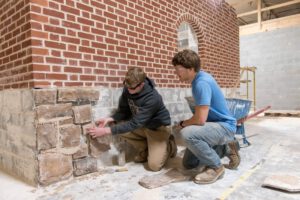Home » Posts tagged 'masonry'
Tag Archives: masonry
Masonry Basics
Pro Angle Masonry Charleston is the art of combining basic building units like bricks, stone, concrete blocks, and pre-cast hollow blocks.
In ancient times, masonry was used to build some of the world’s most spectacular structures.
Today, masonry is a common method of construction. Its popularity is driven by the demand for new buildings and road construction.
A brick is a type of building material that is molded into oblong blocks and fired in a kiln or baked in the sun. These blocks are usually red or brown in color and can be used for building walls, paving, and other applications.
They are an important part of masonry construction and have been used for thousands of years. They are made from clay mixed with water and can be shaped into different shapes using various methods.
The bricks are fired at a high temperature, which causes the materials to bond together and adhere to each other. There are many types of brick, each with a unique shape and function.
Sand lime bricks are commonly used for structural foundations, exposed bricks, and pillars. They are a popular choice for constructing homes and commercial buildings. They are also available in a wide range of colors and finishes.
Concrete blocks are another masonry material that is popular for use in buildings, and they come in a variety of sizes. They are also versatile and affordable options for most building projects.
The block is held together with mortar, which is a mixture of sand, cement, and gypsum in the proper proportions. The mortar is poured into the joints between bricks to ensure that they adhere well and form a solid structure.
There are four basic types of bricks: un-fired, fired, chemically set, and compressed earth blocks. They can be manufactured from a wide variety of materials, including clay, concrete, limestone, sand, and fly ash.
They are generally more durable than mud bricks, which are created from a combination of silt, sand, and other earth materials mixed with tempers and binding agents such as chopped straw, grass, or dung. Mud bricks are naturally flammable and can be very difficult to make, so they are not suitable for residential use.
There are several different types of refractory bricks that are used in the glass and metallurgy industries. These bricks need to be very strong, durable, and able to withstand high temperatures. They also must have excellent thermal shock resistance, refractoriness under load, high melting point, and satisfactory porosity. These bricks are often used for lining furnaces to increase their fire resistance and durability.
There are a variety of stone types used in masonry. Igneous, metamorphic, and sedimentary rock varieties are all excellent masonry materials. They range from strong and durable to aesthetically pleasing. Each type of stone has unique properties, so it’s important for professional masons to choose the right ones for their projects.
Igneous rocks are commonly used in stone masonry because they are extremely hard and durable. They also come in a wide variety of colors. Igneous rock is usually cut into long, rectangular blocks for use in masonry construction.
In this type of masonry, the surface of each stone is roughened by hand using tools, but the sides are kept straight. A 25-mm-wide strip is carved around the outer edge of each stone, and projections larger than 80 mm on the exposed face are removed by light hammering.
This type of masonry is often used in buildings that have heavy load-bearing structures, such as dams and lighthouses. It’s also used to construct piers and columns.
Another type of masonry is dry rubble masonry, which is constructed without mortar. This is a common technique in hilly regions, where high-quality stones are plentiful and affordable.
The masonry is built with a combination of flints or cobbles and facing stones. The masonry is arranged in courses and is usually built to the same height, with smaller stones placed between them to complete each course.